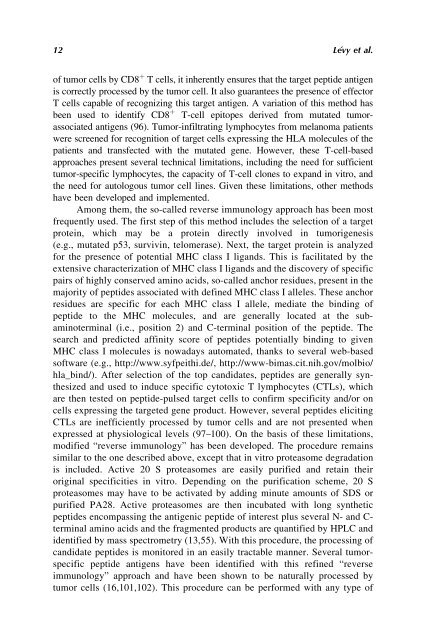Download File - JOHN J. HADDAD, Ph.D.
Download File - JOHN J. HADDAD, Ph.D.
Download File - JOHN J. HADDAD, Ph.D.
Create successful ePaper yourself
Turn your PDF publications into a flip-book with our unique Google optimized e-Paper software.
12 Lévy et al.<br />
of tumor cells by CD8 þ T cells, it inherently ensures that the target peptide antigen<br />
is correctly processed by the tumor cell. It also guarantees the presence of effector<br />
T cells capable of recognizing this target antigen. A variation of this method has<br />
been used to identify CD8 þ T-cell epitopes derived from mutated tumorassociated<br />
antigens (96). Tumor-infiltrating lymphocytes from melanoma patients<br />
were screened for recognition of target cells expressing the HLA molecules of the<br />
patients and transfected with the mutated gene. However, these T-cell-based<br />
approaches present several technical limitations, including the need for sufficient<br />
tumor-specific lymphocytes, the capacity of T-cell clones to expand in vitro, and<br />
the need for autologous tumor cell lines. Given these limitations, other methods<br />
have been developed and implemented.<br />
Among them, the so-called reverse immunology approach has been most<br />
frequently used. The first step of this method includes the selection of a target<br />
protein, which may be a protein directly involved in tumorigenesis<br />
(e.g., mutated p53, survivin, telomerase). Next, the target protein is analyzed<br />
for the presence of potential MHC class I ligands. This is facilitated by the<br />
extensive characterization of MHC class I ligands and the discovery of specific<br />
pairs of highly conserved amino acids, so-called anchor residues, present in the<br />
majority of peptides associated with defined MHC class I alleles. These anchor<br />
residues are specific for each MHC class I allele, mediate the binding of<br />
peptide to the MHC molecules, and are generally located at the subaminoterminal<br />
(i.e., position 2) and C-terminal position of the peptide. The<br />
search and predicted affinity score of peptides potentially binding to given<br />
MHC class I molecules is nowadays automated, thanks to several web-based<br />
software (e.g., http://www.syfpeithi.de/, http://www-bimas.cit.nih.gov/molbio/<br />
hla_bind/). After selection of the top candidates, peptides are generally synthesizedandusedtoinducespecificcytotoxicTlymphocytes(CTLs),which<br />
are then tested on peptide-pulsed target cells to confirm specificity and/or on<br />
cells expressing the targeted gene product. However, several peptides eliciting<br />
CTLs are inefficiently processed by tumor cells and are not presented when<br />
expressed at physiological levels (97–100). On the basis of these limitations,<br />
modified “reverse immunology” has been developed. The procedure remains<br />
similar to the one described above, except that in vitro proteasome degradation<br />
is included. Active 20 S proteasomes are easily purified and retain their<br />
original specificities in vitro. Depending on the purification scheme, 20 S<br />
proteasomes may have to be activated by adding minute amounts of SDS or<br />
purified PA28. Active proteasomes are then incubated with long synthetic<br />
peptides encompassing the antigenic peptide of interest plus several N- and Cterminal<br />
amino acids and the fragmented products are quantified by HPLC and<br />
identified by mass spectrometry (13,55). With this procedure, the processing of<br />
candidate peptides is monitored in an easily tractable manner. Several tumorspecific<br />
peptide antigens have been identified with this refined “reverse<br />
immunology” approach and have been shown to be naturally processed by<br />
tumor cells (16,101,102). This procedure can be performed with any type of

















